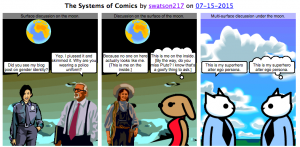#accidentalalliteration Make Cycle #4 for Making Learning Connected Course.
Susan Watson cracked me up with her comic, The Systems of Comics. She is very clever and funny.
That’s too small to read but you can see the original here. Terry must have made hundreds of these. Here’s one. I decided to try and make my own. It is the first in a series of Personal Conversations at Melbourne High School.

I’m sure that’s illegible so take a look at the original.
I have a plan for this series and also for another to give our students voice. I’ve already asked some of our students for help. This should be fun.
And the Bigger (AlmostEvil) Plan is to infiltrate learning spaces in my school like a stealthy villain. One of my recent posts expressed frustration about the school system which resists reform and may have to be levelled first in order to be rebuilt. After reading Terry’s comment
I think I am done with reform as a way of re-thinking. I put a lot more faith in kind subversion, asking forgiveness and not permission, under the radar, subrosa, authentic learning.
I decided to act on an unformed idea I’d had nagging me for a while.
Taking the library out to the school is not a new idea but I think I need to up the ante with it. My new, as yet embryonic, idea is to hack the staffroom in a surprising way. Something along the lines of setting up a small and changeable pop-up shop/library when nobody’s looking. For example, mark the space somehow with a few artifacts, then leave things that beg to be played with and change these regularly. Some ideas so far: puzzles, gorgeous design pages for colouring in, quirky articles – and comics! Like this one. So I envisage leaving one comic per series and updating regularly. Series like ‘Professional conversations at MHS’ and ‘Student conversations at MHS’, and so on.
I’m trying a soft approach to hacking the school system. If, as I’ve said in a previous post, teacher librarians find it challenging to collaborate with teachers because teachers are driven to keep up with the curriculum, then we can entice them, seduce them in a way, with curriculum-irrelevant playful things that help them slow down, make things, laugh, and take a break from the system. Why not? My aim is to distract teachers, disrupt their single focus so that they might be more open to joining me in collaborative play in class.
And if that’s too ambitious, at least their (mis-)perception of teacher librarians (another blog post) might be popped like a giant bubble containing nothing but air. And that created space is something I will try to inhabit.
All ideas for a soft hack of learning spaces will be taken seriously and collected in a special container.
Oh, and true to villains who leave calling cards, here’s one I made with Notegraphy for my library.

Of course, it could just as easily look like this.

I’m looking forward to sharing this idea with my colleagues in the school library.

